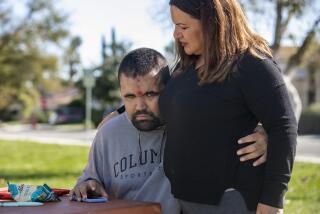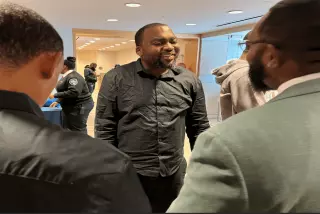For One Goetz Victim, Suffering Wonât End : South Bronx: Youth was immobilized from the waist down, fell into a coma, suffered irreversible brain damage. Now 29, he has the mental capacity of a third-grader.
NEW YORK â Shirley Cabey saved all the letters--the ones that called her son a ânigger,â that wished the boy had died, that threatened his life if he survived the gunshot that sliced through his spine.
Each note, with its ugly words and racial venom, sits pressed today inside the Cabey familyâs Bible. The Good Book, like Shirley and her son Darrell, remains where it was when the letters arrived 10 years ago--in an apartment in a South Bronx housing project.
The letters literally added insult to injury: They started after Darrell was shot by subway gunman Bernie Goetz. Cabey was paralyzed from the waist down, fell into a coma, suffered irreversible brain damage. He is now 29 years old, with the mental capacity of a third grader.
Darrell Cabey is growing old, but he will never grow up.
âThe years have gone by so quickly,â Shirley Cabey reflected recently. âItâs still hard. Very hard.â
It was Dec. 22, 1984, when Goetz shot four youths on a Manhattan subway train--Cabey, James Ramseur, Barry Allen and Troy Canty. Goetz said the four were about to mug him.
He admitted walking up to a wounded Cabey, sticking a gun into his torso and announcing, âYou donât look too bad, hereâs anotherâ before pulling the trigger a second time.
Cabeyâs lawyer, William Kunstler, said that point-blank shot left his already wounded client paralyzed. Goetz claimed his gun was empty at that point, that he had already shot Cabey once and missed the teen with a second shot.
The details arenât important to Shirley Cabey, whose son was instantly crippled. He nearly died, kept alive only by a respirator for 57 days. He spent 14 months in the hospital, leaving in the wheelchair heâs used ever since.
Once, Shirley Cabey had prayed that her son might escape the South Bronx--maybe to the northern suburbs aboard one of the commuter trains that zipped past their apartment every day.
Instead, he boarded a southbound No. 2 subway to Manhattan.
âI wanted Darrell to go back to school and finish up,â Cabey says of her son, breaking years of silence, âto do whatever heâs capable of doing. But now. . . . â
Now, Darrell Cabey cannot tell you the day of the week, the month, or the year, his doctors say. His vocabulary is limited. He does not know the name of the mayor or the governor. He doesnât know how he wound up in a wheelchair, his mother said.
Cabey spends his weekdays in a Bronx rehabilitation center, his weekends in the apartment watching horror videos. While Goetzâs three other victims committed subsequent crimes, an outstanding criminal charge against Cabey was dropped in 1985 when the Bronx district attorney determined he had the capacity of an 8-year-old.
âHe used to be outgoing. He enjoyed dressing, looking good, all that,â Cabey recalled. âNow, heâs not the same.â
Only Goetz denies the extent of his injuries. In battling Darrell Cabeyâs $50-million lawsuit, Goetz charged that Cabey is exaggerating his injuries.
âHe has some brain damage, yes,â said Goetz. âBut he is not in the vegetative state that he pretends to be in.â
Goetz, who was convicted on a single weapons charge in the shooting and spent 250 days in jail, blames Cabey for trying to mug him. His opinion of Cabeyâs injuries has never wavered, even after two depositions where he questioned Cabey and couldnât elicit any answer longer than a single sentence.
âHave you ever heard the name Bernie Goetz before?â Goetz asked in the June, 1993, session.
âNo, I havenât,â Cabey replied.
Shirley Cabey said she doesnât dwell on Goetz or the shooting: âIn order to keep my sanity, I donât do much talking.â She tries to remember her son the way he once was.
âI donât see his wheelchair,â Cabeyâs mother said. âThatâs how I look at it. And God has been with me since day one. When youâve got him beside you, it makes a big difference.â
At a United Cerebral Palsy facility in the Bronx, Cabey spends hours doing simple repetitive tasks--sometimes successfully, sometimes not, says his lawyer, Ron Kuby.
Mrs. Cabey said her son is âlearning new things all over again. Itâs getting better, but itâs still not the same.â
These days, Darrellâs world revolves around the Cabey apartment, its VCR, the cerebral palsy facility. âMostly, he stays in,â said Mrs. Cabey. Family, friends and a home attendant help Darrell cope.
If Darrell canât remember what happened, his mother canât forget.
âHeâs taken it very well, the whole thing,â said Mrs. Cabey. âI thought he was going to be depressed, angry. . . . He doesnât even question what happened.
âIâm more depressed than he is.â
More to Read
Sign up for Essential California
The most important California stories and recommendations in your inbox every morning.
You may occasionally receive promotional content from the Los Angeles Times.










